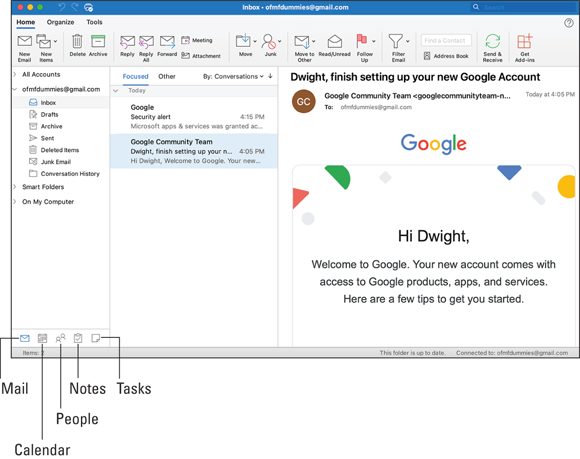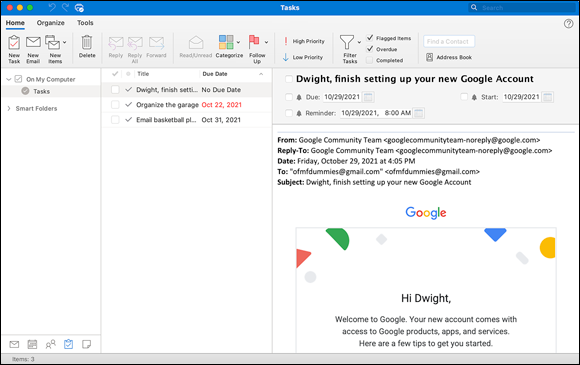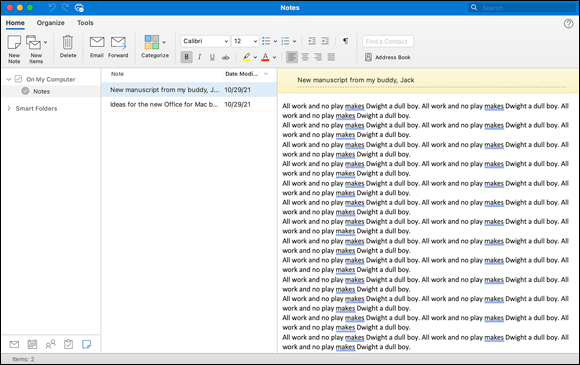Chapter 17
Getting to Know Outlook
IN THIS CHAPTER
![]() Introducing Outlook
Introducing Outlook
![]() Taking a tour of the major Outlook features
Taking a tour of the major Outlook features
![]() Checking out all five Outlook modules
Checking out all five Outlook modules
One member of the Office for Mac quartet is Outlook. Compared to the others, it’s an odd duck. You see, whereas each of the other three Office for Mac apps excels (pun intended) at a single task — word processing for Word, slideshows for PowerPoint, and spreadsheets for Excel — Outlook is more like five apps in one. To be precise, it includes five modules:
- An email client
- An appointment calendar
- A contacts manager
- A task manager
- A repository for notes
Put ’em together and what do you have? Microsoft Outlook, the Swiss army knife of Office for Mac apps. If we had to come up with a single name for everything Outlook does, we’d call it a personal information manager. In this chapter, you take a quick look at each of the five modules and how you might want to use them.
Taking a Quick Tour of Outlook
In contrast to the other Office apps, Outlook’s five “views” don’t appear on the status bar or on the View menu. Rather, you switch between them using the icons in the view switcher (at the lower left side of the window) or keyboard shortcuts.
Because each of the five modules has a slightly different interface, ribbon, and menu items, we offer the following sections to help acquaint you with the look and feel of each one.
The Mail module
The Mail module is a lot like the Apple Mail app that comes with your computer, as you can see in Figure 17-1. To activate it, press ⌘ +1 or click the envelope icon in the view switcher (in the lower-left corner).

FIGURE 17-1: Outlook Mail module.
As Apple Mail does, the Outlook Mail module offers a variety of folders for your mail and a junk mail filter. Instead of a toolbar, however, Outlook offers icons on the now-familiar ribbon.
For details on the Mail module, see Chapter 18.
The Calendar module
The Outlook Calendar module (shown in Figure 17-2) is a lot like the macOS Calendar app that comes with your Mac. You activate the Calendar module by pressing ⌘ +2 or clicking the calendar icon in the view switcher.

FIGURE 17-2: The Outlook Calendar module.
And, once again, the choice of which to use — the Outlook Calendar module or the macOS Calendar app — comes down strictly to your preference. There’s no huge advantage to using one or the other. Try both and use whichever one you prefer.
You can find out more about the Calendar module in Chapter 19.
The People module
The People module is a lot like the Apple Contacts app that comes with macOS, as you can see in Figure 17-3. You activate it by pressing ⌘ +3 or clicking its icon in the view switcher.
You can learn more about the People module in Chapter 19.

FIGURE 17-3: The Outlook People module.
The Notes and Tasks modules
The Outlook Tasks and Notes modules, shown in Figures 17-4 and 17-5, essentially duplicate the functionality of the macOS Reminders and Notes apps, respectively. See MacOS Monterey For Dummies, written by Bob “Dr. Mac” LeVitus, for details about using the macOS Mail, Contacts, Reminders, Notes, and Calendar apps.
You activate the Tasks module by pressing ⌘ +4 or clicking its icon in the view switcher. Chapter 19 tells you much more about creating and using tasks in Outlook. As for the Notes module, you activate it by pressing ⌘ +5 or clicking its icon in the view switcher. You can read more about the Notes module in Chapter 19 as well.

FIGURE 17-4: The Outlook Tasks module.

FIGURE 17-5: The Outlook Notes module.

 Feature for feature, Outlook and Apple Mail are more alike than different. Why use one instead of the other? Mostly, it’s a matter of preference. If you’re accustomed to using Outlook for Windows or you’re using the other Office for Mac programs extensively, you might prefer Outlook for its similarities and integration with those apps or to make use of Outlook rules and categories. (You can find out more about these features in
Feature for feature, Outlook and Apple Mail are more alike than different. Why use one instead of the other? Mostly, it’s a matter of preference. If you’re accustomed to using Outlook for Windows or you’re using the other Office for Mac programs extensively, you might prefer Outlook for its similarities and integration with those apps or to make use of Outlook rules and categories. (You can find out more about these features in